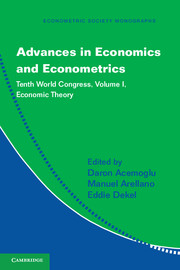Book contents
- Frontmatter
- Contents
- Contributors
- Preface
- I NONSTANDARD MARKETS
- II CONTRACTS
- III DECISION THEORY
- IV COMMUNICATION/ORGANIZATIONS
- V FOUNDATIONS: EPISTEMICS AND CALIBRATION
- 12 Strategies and Interactive Beliefs in Dynamic Games
- 13 Calibration: Respice, Adspice, Prospice
- 14 Discussion of “Strategies and Interactive Beliefs in Dynamic Games” and “Calibration: Respice, Adspice, Prospice”
- VI PATENTS: PROS AND CONS FOR INNOVATION AND EFFICIENCY
- Name Index
- Miscellaneous Endmatter
12 - Strategies and Interactive Beliefs in Dynamic Games
Published online by Cambridge University Press: 05 May 2013
- Frontmatter
- Contents
- Contributors
- Preface
- I NONSTANDARD MARKETS
- II CONTRACTS
- III DECISION THEORY
- IV COMMUNICATION/ORGANIZATIONS
- V FOUNDATIONS: EPISTEMICS AND CALIBRATION
- 12 Strategies and Interactive Beliefs in Dynamic Games
- 13 Calibration: Respice, Adspice, Prospice
- 14 Discussion of “Strategies and Interactive Beliefs in Dynamic Games” and “Calibration: Respice, Adspice, Prospice”
- VI PATENTS: PROS AND CONS FOR INNOVATION AND EFFICIENCY
- Name Index
- Miscellaneous Endmatter
Summary
Introduction
Interactive epistemology in dynamic games studies forms of strategic reasoning such as backward and forward induction by means of formal representations of the players' conditional beliefs about one another, given the histories that can occur in the game being played. Most of the received literature relies on state-space models in which a state specifies both the players' strategies and their conditional beliefs. A player's strategy associates every history (or, node) at which the player is active in an action available at that history. This is interpreted objectively, as a description of what the player would actually do at every such history, even at those that do not happen at the state. In particular, a player's strategy is a primitive object, described separately from her beliefs. To be sure, it can be the object of the player's own beliefs – whereby, typically, she is certain of it – but it is not expressed in terms of beliefs.
A more intuitive interpretation of a strategy – in particular, the correct one in contexts in which players cannot delegate their choices to mechanical devices – is, however, that of a subjective plan describing what the player thinks she would choose, at each history of hers, if that history occurs. Under this interpretation, prescriptions of actions to be chosen at unreached histories can reflect only a player's belief about her own behavior, conditional on counterfactual events. Most existing epistemic models, therefore, bring about a language that is both implicit – that is, behavior and beliefs about own behavior are conflated in a single mathematical object, the strategy – and possibly restrictive – such conflation hides implied underlying assumptions, as we discuss in the last section of this chapter.
- Type
- Chapter
- Information
- Advances in Economics and EconometricsTenth World Congress, pp. 391 - 422Publisher: Cambridge University PressPrint publication year: 2013
- 1
- Cited by

